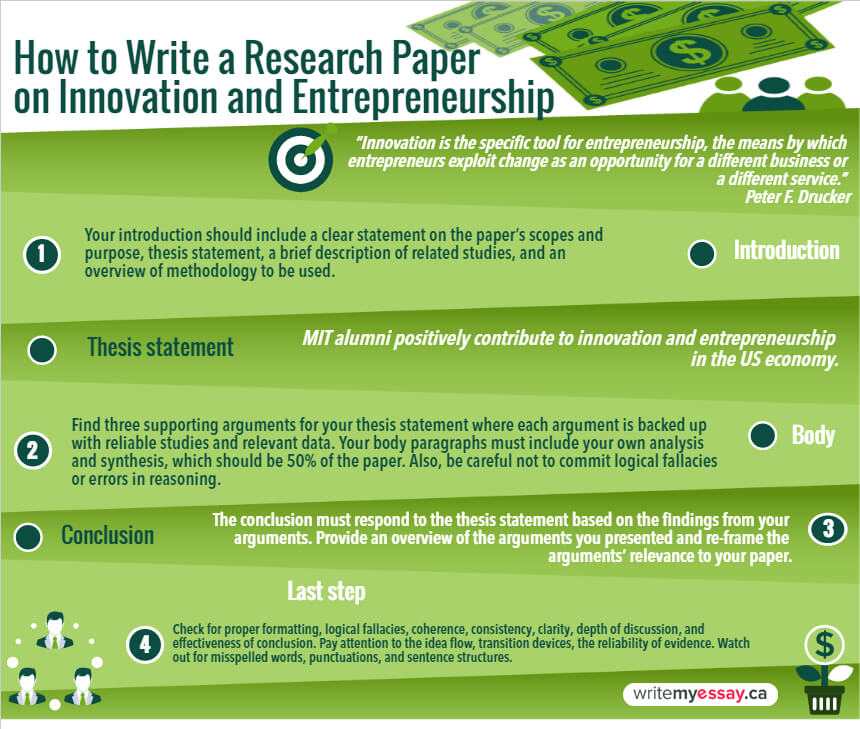
How to Write a Research Paper on Innovation and Entrepreneurship

Table of Contents
Research Paper on Innovation and Entrepreneurship
- How to start a research paper on innovation and entrepreneurship
- Example of the outline
- How to write the thesis
- How to write the introduction
- Example of the introduction with the thesis statement
- How to structure body paragraphs for the research paper on innovation and entrepreneurship
- Example of the 1st body paragraph
- Example of the 2nd body paragraph
- Example of the 3rd body paragraph
- How to finish the research paper on innovation and entrepreneurship
- Example of the conclusion
- Research paper revision

A research paper normally contains analysis, interpretations, and evidence of an author regarding a particular topic. This guide will give you a walkthrough on completing your research paper on innovation and entrepreneurship.
How to start a research paper on innovation and entrepreneurship
Before writing your paper, you must understand the assignment. What are the limits on the number of words or pages? What are the allowed citation format and type of sources (books, online, etc.)? What should be the formatting details (font style/size, footnotes, etc.)? When is the deadline?
Since you will be writing a research paper on innovation and entrepreneurship, the next thing to do is to conduct a quick research related to the subject. From these researches, select only a related topic that you can manage to write about later on.
Example of the outline
Now that you have decided on your focus, establish an outline to help you logically organize the things you must include in your paper. This should follow from your thesis statement. As per research paper format, your writing must include an introduction, body, and conclusion. For this guide, see sample outline below:
I. Introduction
- MIT alumni positively contributing to innovation and entrepreneurship in the US economy
II. Measure of Impact
- Geographic Impact (with supporting details)
- Impact on Employment and Revenues (with supporting details)
- Serial Entrepreneurship (with supporting details)
III.CONCLUSION
- Summary of analysis
- Concluding statement
How to write the thesis statement
From the selected topic, decide your focus to formulate a thesis statement, which is the central idea of your paper. A thesis statement:
- Must be provided early in your paper, preferably within the introduction
- Must be clear and concise
- Must include your position on the issue at hand
For the purpose of this guide, see sample below:
- Topic – Innovation and entrepreneurship in the US.
- Question – Do MIT alumni impact the US economy through innovation and entrepreneurship?
- Thesis – MIT alumni positively contribute to innovation and entrepreneurship in the US economy.
How to write the introduction
To start with the writing proper, here are tips on what you should include in your introduction:
- Clear statement on the paper’s scopes and purpose
- Defined thesis statement
- Brief description of related studies
- Overview of methodology to be used
- Must be able to capture even non-experts among the readers
Example of the introduction with the thesis statement for a research paper on innovation and entrepreneurship
For this guide, the sample introduction is:
In 2003, Professor Edward Roberts of MIT conducted the first study exploring entrepreneurial ventures of MIT alumni and its contribution to the US economic growth. Other universities such as Stanford, Tsinghua (China), the Technion (Israel), and University of Virginia followed suit with their own alumni. In 2014, MIT updated the same study in order to measure its alumni’s the positive impact to the US economy through innovation and entrepreneurship. The latest study aimed to see whether MIT alumni positively contributed to innovation and entrepreneurship in the US economy in terms of geographic impact, impact on employment and revenues, and serial entrepreneurship.
How to structure body paragraphs
A body paragraph is where you present your argument with evidence that prove your thesis statement. Given this is a research paper, you must follow a rigid structure so that your output becomes comprehensible. Here are useful tips to help you structure your body paragraphs:
- The common rule is to find three (3) supporting arguments for your thesis statement.
- Each supporting argument must be backed up with reliable studies, stats, graphs and other needed materials.
- Must include your own analysis and synthesis, which should be 50% of the paper.
- Use proper citation for your sources; do not plagiarize.
- Be careful not to commit logical fallacies or errors in reasoning.
The outline should guide you on how you should organize your thoughts on paper so that you can effectively communicate your message. For a comprehensive output, include graphs, computations, etc. for evidence. For this guide, take a look at the sample body paragraphs below. Note that these can still be elaborated i.e. the research methodology used, supporting statistics/graphs, and your own insights.
Example of the 1st body paragraph
The first measure of MIT alumni contribution to innovation and entrepreneurship in the US economy is a geographic impact. MIT alumni were found to have a direct impact on the local and regional economies due to their presence in these areas. One example was Massachusetts which housed the most number of MIT alumni companies at 31% (1,691 companies). This was followed by California at 21%. At the city level, Cambridge had the most number of MIT alumni companies at 8%. This geographic impact was not limited to the US, as about 23% of MIT alumni founded their companies outside the US.
Example of the 2nd body paragraph
Aside from geographic impact, MIT alumni had a substantial impact on the US economy through employment and revenues. About 51% of MIT alumni-founded companies employed less than ten (10) employees. 27.8% employed around 11 up to 50 employees, while 12.6% had 51 up to 200 employees. Nevertheless, the 2.3% who employed more than 1,000 people accounted for 68% total employment and 42% total revenues.
Example of the 3rd body paragraph
Last but not least was the measure of serial entrepreneurship among MIT alumni. During their careers, about 40% of MIT alumni entrepreneurs have launched two or more firms. The rate of business venture failure for first-time founders was 37.8%, compared to 27.7% for an experienced founder and 29.2% for an experienced founder in familiar industry. Somehow, these results showed improving learning curve for MIT alumni as they venture into new businesses which could positively impact the economy.
How to finish a research paper on innovation and entrepreneurship
Now that you have exhausted your arguments to prove your thesis statement, it is time to wrap up your research paper with a conclusion. A strong conclusion will make your paper feel complete, leaving readers satisfied with what they have learned from you. Here are tips to write your conclusion:
- Conclusion must respond to the thesis statement based on the findings from your arguments.
- Provide overview on the arguments you presented.
- Re-frame the arguments’ relevance to your paper.
- Present here recommendations you think that must be done regarding the topic e.g. needs further research.
- No speculation or any new information must be presented here.
Example of a conclusion
Shown below is a sample of the conclusion. Again, this can still be elaborated for better comprehension:
This study was able to reveal that MIT alumni were indeed positively contributing to innovation and entrepreneurship in the US economy through their businesses. A quick review would reiterate MIT alumni businesses’ presence both locally and internationally. It was also found that the businesses employing less than 1,000 people contributed to the majority of revenues. Furthermore, the number of serial entrepreneurs was expected to grow. The interesting thing was about one-third of MIT alumni were inventors, and about one-half were innovators. The implication of this study was to further see how MIT’s innovation-oriented education helps its graduates be successful in terms of innovation and entrepreneurship.
Research paper revision
You should revise your research paper to exclude all errors. At the overall organization level, check for proper formatting, logical fallacies, coherence, consistency, clarity, depth of discussion, and effectiveness of conclusion. At the paragraph level, pay attention to the idea flow, transition devices, the reliability of evidence, and so on. At the sentence level, watch out for misspelled words, punctuations, and sentence structures. You may use online proofreading tools such as Grammarly and Turnitin, or even ask peer reviews on your research paper.
- Roberts, et al. (2015). Entrepreneurship and Innovation at MIT: Continuing Global Growth and Impact. MIT Sloan School of Management.


